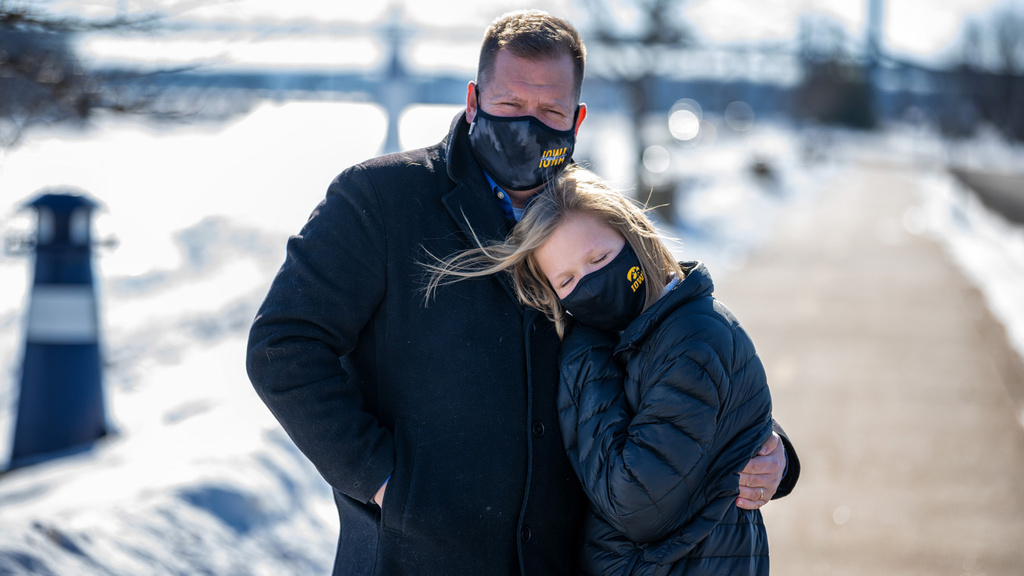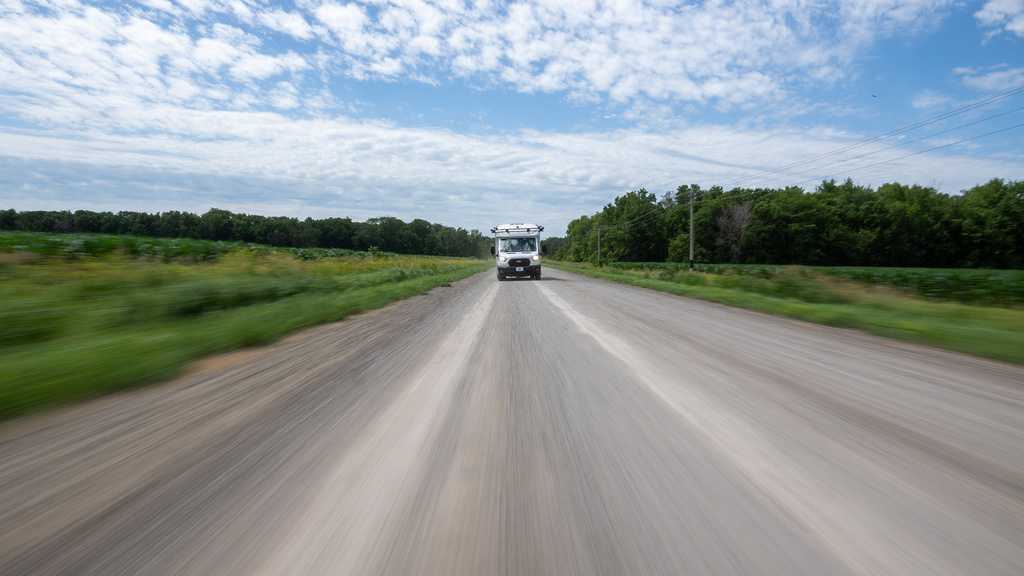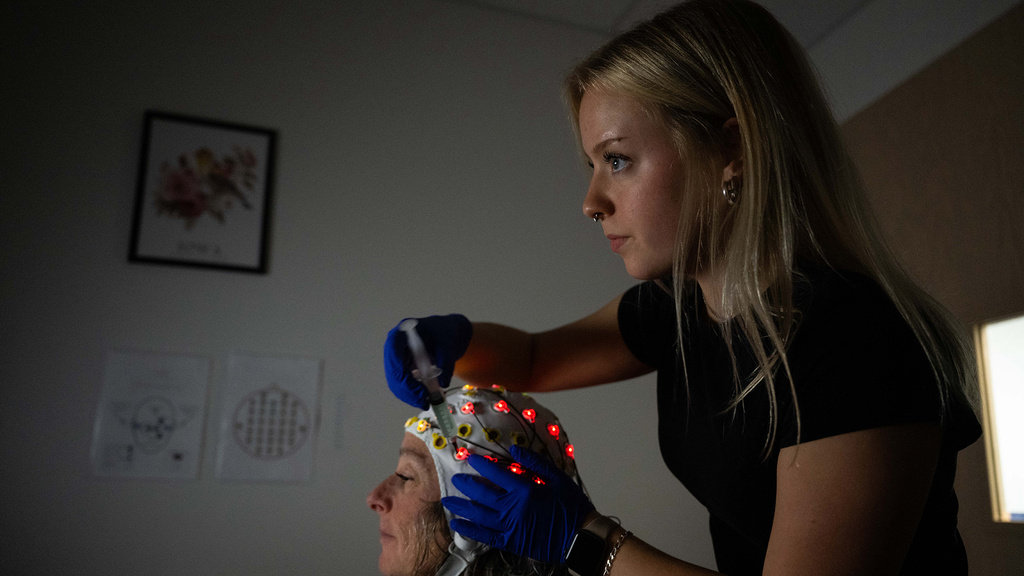University of Iowa researchers have been following 300 children with hearing loss for nearly 14 years, and their findings are changing lives, the field of audiology, and public policy.
Story: Emily Nelson
Photography: Tim Schoon
Published: Oct. 26, 2021
The top photo...
Ben Hinners participates in University of Iowa hearing-loss research in a customized mobile clinic. The Iowa researchers often travel in the mobile clinic to assess participants in their home communities.
On Hunter Martin’s first day of preschool, his teacher asked each student to tell the class about something fun they did over the summer.
“I said I went into a white van where they asked me questions and took my photo and gave me candy,” Hunter, now 13, recalls.
While such a story might normally raise red flags, Hunter’s teacher was a friend of his mother, Ramona, and knew that the white van was actually a mobile testing clinic used by University of Iowa researchers studying hearing loss in children.
Hunter and his brother, Owen, 10, have been participants since they were 2 years old and 6 months old, respectively, in a first-of-its-kind study that has improved resources for children with hearing loss, advanced the field of audiology, and influenced public policy.
Hearing is critical to a child’s development—particularly in language and speech development, social skills, and academic achievement. But while much is known about the development of children who are severely to profoundly deaf, they make up only 20% of children with hearing loss. Until recently, much less was known about the other 80% of children who are hard of hearing, meaning they have mild to severe hearing loss.
Before the early 2000s, research funding tended to go toward children who were severely to profoundly deaf, particularly in the area of cochlear implants.
“That was new technology in the ’90s and early 2000s, and they needed data to show that cochlear implants worked,” says Elizabeth Walker, associate professor in the University of Iowa Department of Communication Sciences and Disorders and director of the Pediatric Audiology Lab. “But there was this whole other population of kids who were not receiving much attention in the research community. So, they were getting a bit overlooked in classroom settings and special education.”
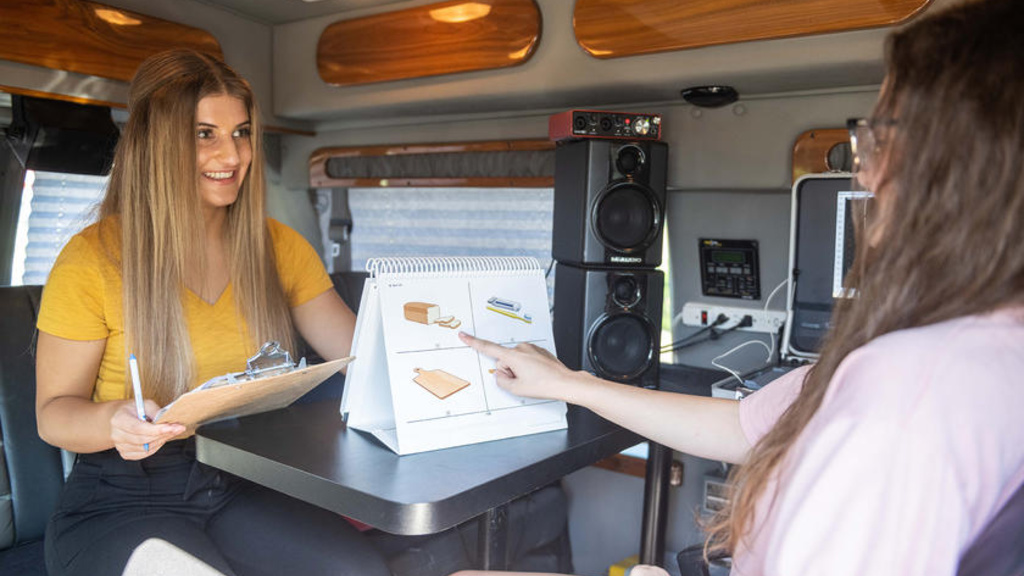
Playing a key role in crucial research
Evita Woolsey came from California to the University of Iowa to pursue her interest in speech and hearing science. Through her involvement in an NIH-funded research project, the undergraduate is assessing children across the state and making connections with researchers on campus and beyond.
In 2008, researchers at the University of Iowa, Boys Town National Research Hospital in Omaha, and the University of North Carolina at Chapel Hill began the Outcomes of Children with Hearing Loss (OCHL) study, funded by the National Institutes of Health. The study started following more than 300 children who were hard of hearing and 100 children without hearing loss during infancy and preschool years to examine developmental outcomes of children with hearing loss. A second grant allowed researchers to continue following the children through elementary school.
Now these children are in junior high and high school, and a third grant is funding the project through 2026.
“People often think you have normal hearing or you’re deaf, which is interesting because you never say that about vision—that you have normal vision or you’re blind,” Walker says. “There’s this whole spectrum of hearing loss, just like with vision. But hearing loss doesn’t always get treated that way. I think part of the reason is that hearing loss is more of a hidden disability.”
Hoping to learn more about their children
Ramona Martin says she learned about the study from Hunter’s audiologist.
“Hearing loss does not run in our family, and not knowing how the boys were going to progress, I was excited for them to join so they could be tracked and see if they progress like their peers without hearing loss or where their deficits were so we could address them,” says Martin, whose family lives in Illiopolis, Illinois.
Kimberly Prendergast says that sense of not knowing also played into the Oskaloosa, Iowa, family’s decision to sign their daughters up for the study. Molly, 13, and Ruby, 10, were 18 months and 6 months old, respectively, when they joined.
“We worried about Molly’s hearing loss a lot as a baby and as a toddler,” Prendergast says. “We worried about it less and less over the years because she’s obviously got it under control and it’s just not even an issue. So, when Ruby came along and didn’t pass her newborn hearing screening, we weren’t as fazed because we had a 3-year-old at home who was already learning how to read. But we were told when Molly was a baby that there wasn’t a lot of information about kids like her and more information was needed, so we were happy to help further the knowledge in the field.”
Testing clinic comes to the kids
While some study participants come to the Wendell Johnson Speech and Hearing Clinic at the University of Iowa for annual assessments, researchers more often go to them in a customized mobile clinic.
“It’s so convenient for families because we can test in their driveway, at their school, or their day care. Their families can always come to the van, say hello, and see what we’re doing,” says Evita Woolsey, a fourth-year student from Encinitas, California, who has worked in the lab for two years and helped with data collection for the study over the summer. “You can tell that the kids are very comfortable with us being there.”
Hunter and Owen Martin each have a twin who doesn’t have hearing loss, and the family has come to Iowa City so all four kids could be included in certain studies, but Ramona Martin says they prefer the van.
“They can do almost any test in the van that they can do in the clinic, and the boys have always thought that was really cool,” Martin says. “They are sad when they don’t get to go to the van.”
Annual assessments can take up to six hours and include interviews with the parents; checking hearing aids if the child has them; and a battery of language, reading, and psychosocial tests.
The Martin and Prendergast kids say they don’t mind the long sessions and enjoy the tests, but a few over the years have stood out as favorites.
For Molly Prendergast, genetic testing was particularly interesting.
“I’ve learned a lot from this study, especially the spit test because I didn’t really know much about my hearing loss when I was little, and then my brain got bigger and I was sort of asking questions about why do I have this hearing loss?” Molly says. “I’m a person who asks questions, and I think it made me more curious.”
Her mom, Kimberly, remembers when Molly was little that the researchers asked her to wear a vest with a recording device to keep track of how many words and types of language she was getting at home.
“It was funny knowing that your house is being recorded all the time when you have a toddler walking around,” Prendergast says. “And we laughed imagining the graduate students who had to count our words and whatnot.”
Hunter and Owen Martin both enjoyed the day they got an MRI in Iowa City.
“It was cool getting to see my brain,” Hunter says. “I’ve learned a lot about my hearing doing this study.”
Owen had another reason for enjoying the MRI.
“They had candy and they said if I didn’t move, I would get it,” Owen says. “I didn’t move the whole time and got to bring home the whole plate of candy.”
Their mom, Ramona, says she has been impressed by how the Iowa researchers work with the kids.
“They were really good at using kid terminology and getting full buy-in from the kids,” Martin says. “They are pretty smart because I wouldn’t have been able to get buy-in for some of it!”
Woolsey, who is majoring in speech and hearing science and minoring in American Sign Language, says while the testing can be long, she enjoys getting to know the kids she is working with.
“I love chatting with them on breaks and encouraging them throughout the testing,” Woolsey says. “I enjoy the interpersonal relationships you can create with the kids. It’s amazing to hear about the long-term relationships Dr. Walker has formed with these families and how well they know each other.”
The hearing loss study is not interventional, meaning researchers don’t diagnose or treat participating children. However, Walker says she hopes participants and their families find personal benefits to participating.
“Hearing loss is not a common condition. If you have a child with hearing loss, especially in a rural state like Iowa, they may be the only child in the entire town or school with hearing loss,” Walker says. “I hope participating in this study helps make them a little bit more aware that they aren’t the only family that’s dealing with this condition and even feel a bit more empowered to advocate for themselves or their child.”
Ramona Martin says participating in the study has given their family one more tool to ensure the boys are progressing and not hitting a brick wall.
“These two have not fallen behind at all, and I’m very proud of them,” Martin says. “But I think part of it is because of the University of Iowa and Beth and her team, who have been amazing. They have supported us, given us advice, and helped us know what they need and what helps them grow.”
Owen says there also is an added practical benefit for those who participate in the study.
“They can track if our hearing levels are getting better or getting worse and if we need our hearing aids turned up, turned down, or stay where they are,” Owen says.
Hunter and Owen over the years have become excellent advocates for themselves and other children with hearing loss. The two played a key role in lobbying to get an Illinois law passed in 2018 requiring insurance providers to cover new hearing aids for kids 18 and younger every three years.
Martin says she would recommend any parent of a child with hearing loss consider such a study if given the opportunity.
“It’s only going to benefit their children and other children down the line,” Martin says. “The more knowledge that the researchers can get about hearing loss, about different interventions that they can provide, about hearing aids, about everything—it’s going to help all kids with hearing loss in the future. And my kids have enjoyed doing it.”
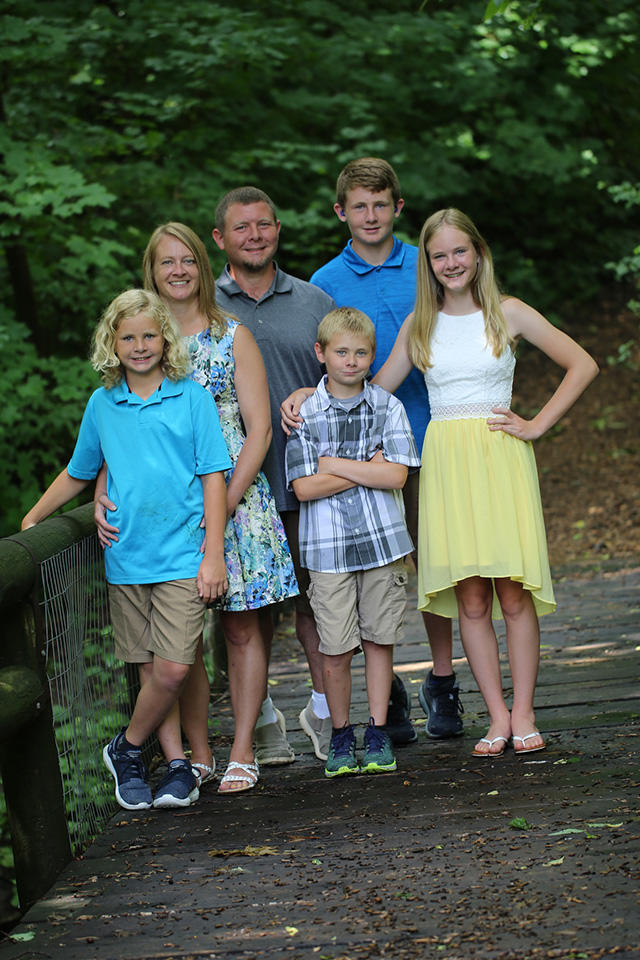
Hunter (back) and Owen (left) Martin over the years have become excellent advocates for themselves and other children with hearing loss. The two played a key role in lobbying to get an Illinois law passed in 2018 requiring insurance providers to cover new hearing aids for kids 18 and younger every three years. (Photo courtesy of the Martin family.)
Making advancements in the field of hearing loss
Among the many findings the study has yielded over the past 14 years, Walker says a couple in particular have stood out: that a large number of children’s hearing aids weren’t fitted appropriately for their hearing loss and that many of the kids weren’t wearing their hearing aids for large parts of the day.
“We were pretty surprised by how many—about 35%—of the kids’ hearing aids were not fitted optimally, which limits how much they can actually help them,” Walker says. “Hearing aids are really expensive, so if you’re going to get them, you want to make sure they’re fitted for your hearing loss.”
As for kids not wearing their hearing aids all the time, Walker says that maybe shouldn’t have been as surprising as it was because there can be a stigma attached to wearing them. Kids just want to fit in with their peers. She says they will be curious to see how this continues to play out as the students go through junior high and high school.
Walker says the evidence clearly shows differences between the growth rates of language skills between children who have appropriately fitted hearing aids and wear them and those who don’t.
“The kids who have the better-fit hearing aids show rising trajectories in their language skills year over year. We see kids whose hearing aids aren’t fitted appropriately falling further behind as they get older,” Walker says. “We see that same trend in terms of hearing aid use. The kids who wear their hearing aids more than 10 hours per day show this steep growth trajectory, but the kids who wear the hearing aids less than 10 hours per day show the opposite trajectory where they’re falling further behind. This is the advantage of collecting prospective longitudinal data—we can see how much progress they are making from year to year.”
The difference that wearing hearing aids more often makes also can be physically seen during magnetoencephalography (MEG), which measures the electrical impulses of the brain.
“This neuroimaging shows that the kids who wear their hearing aids less often have to recruit more parts of their brain to do certain tasks. Their brains have to work harder to achieve the same level of performance,” Walker says. “The kids who wear their hearing aids more often look like the brains of kids with typical hearing.”
One of the study’s biggest impacts on the field of audiology has been to develop criteria to determine when hearing aids would help a child.
“This has always been a really gray area: whether kids with milder degrees of hearing loss should be getting hearing aids or not,” Walker says. “Hearing aids are expensive and not always covered by insurance. So, we don’t want to tell a family to get hearing aids if the child is not going to need them, but we didn’t have good clinical recommendations prior to the study for determining that.”
To do this, researchers used the speech intelligibility index, which quantifies the amount of speech that is audible and usable to a person—basically their access to speech. They found that children who have less than 80% access to speech benefit from hearing aids. Meanwhile, children who have 80% or more access to speech do not appear to reap any more benefit from wearing hearing aids than not wearing them.
University of Iowa Hospitals & Clinics and other health care facilities use the criteria, and governments are beginning to use it to guide their decision-making process for hearing aid candidacy in children. The Canadian province of British Columbia now uses it to support clinical recommendations about hearing aids through their publicly funded health system.
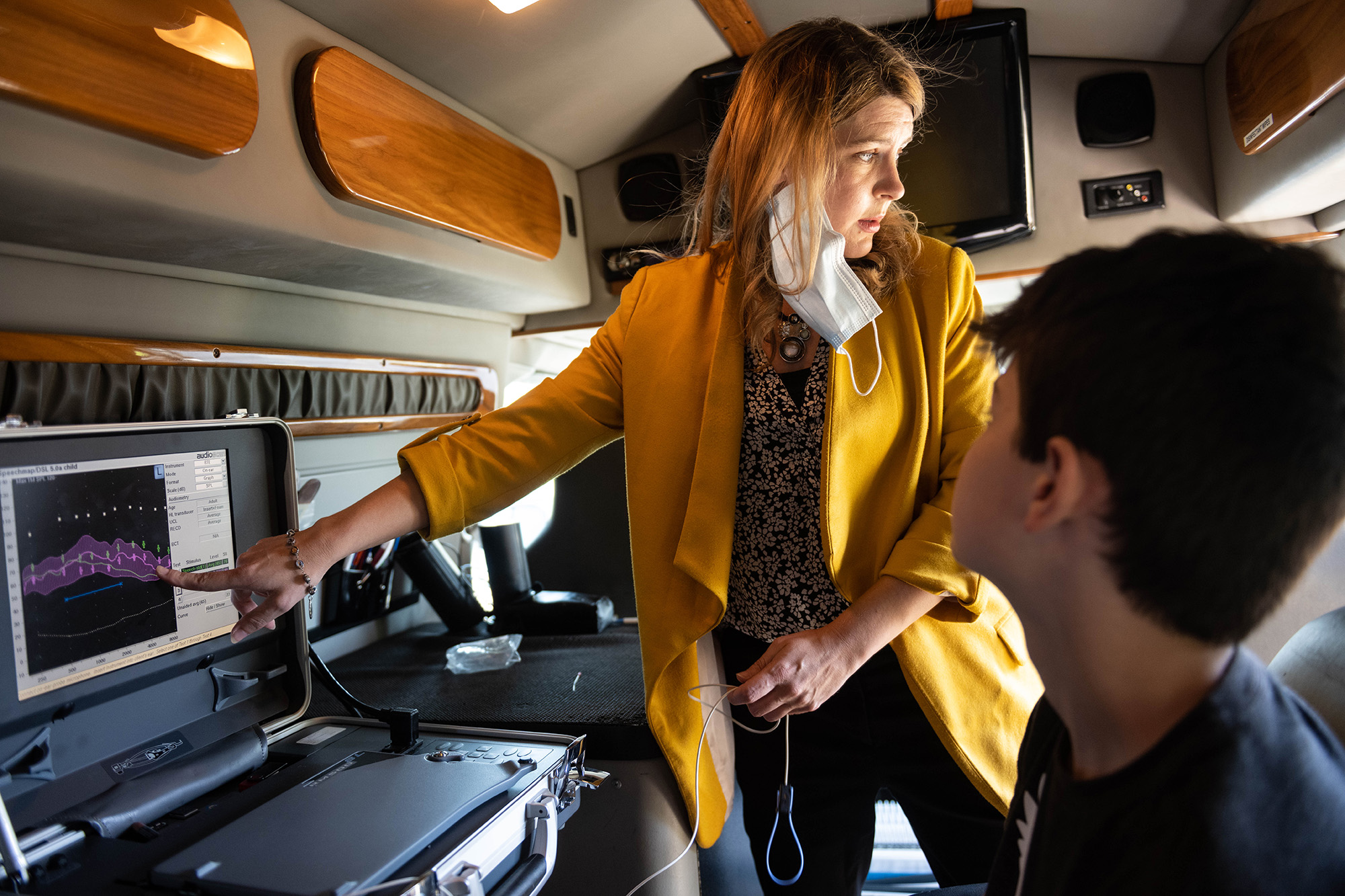
University of Iowa research specialist and audiologist Meggie Dallapiazza works with Ben Hinners in a mobile testing clinic during a recent trip to Solon, Iowa. “It’s so convenient for families because we can test in their driveway, at their school, or their day care. Their families can always come to the van, say hello, and see what we’re doing,” says Evita Woolsey, a fourth-year student from Encinitas, California, who has worked in the lab for two years and helped with data collection for the study over the summer. “You can tell that the kids are very comfortable with us being there.”
“These two have not fallen behind at all, and I’m very proud of them. But I think part of it is because of the University of Iowa and Beth and her team, who have been amazing. They have supported us, given us advice, and helped us know what they need and what helps them grow.”
Molly Prendergast also says she would encourage other people to join research studies.
“It’s made me curious, and every kid should be curious,” Molly says. “It also helps others and is for the betterment of deaf and hard-of-hearing people. It’s just a good thing to do.”
Molly’s mom, Kimberly, says her daughter is a good advocate for herself, helping prepare and send her own 504 plan for school, educating others, and speaking up when she needs something. And speaking up about her hearing loss is nothing new to this high schooler.
“In first grade, we were asked what part of our body was our favorite,” Molly says. “I’m just sort of this unique first-grader who’s kind of her own personality and I didn’t really feel super exasperated about my hearing. I got a photo of my ears with my hearing aids and wrote a paragraph saying that I like my ears because they are unique. I like that I’m different; being different is OK.”
Her confidence may have rubbed off on her little sister, Ruby, who a few years later also named her ears her favorite part of her body.
“It just makes your heart happy that they had the confidence to share that with their classmates and to share that with their teacher,” Prendergast says.
Walker says the story gave her chills.
“I love that story because she was 6 years old and she realized it’s not a disability; it’s something that made her special and that’s a good thing,” Walker says. “When you find out your child has hearing loss, it can be a shock. It’s special watching these families over time accept the hearing loss and appreciate their diversity.”
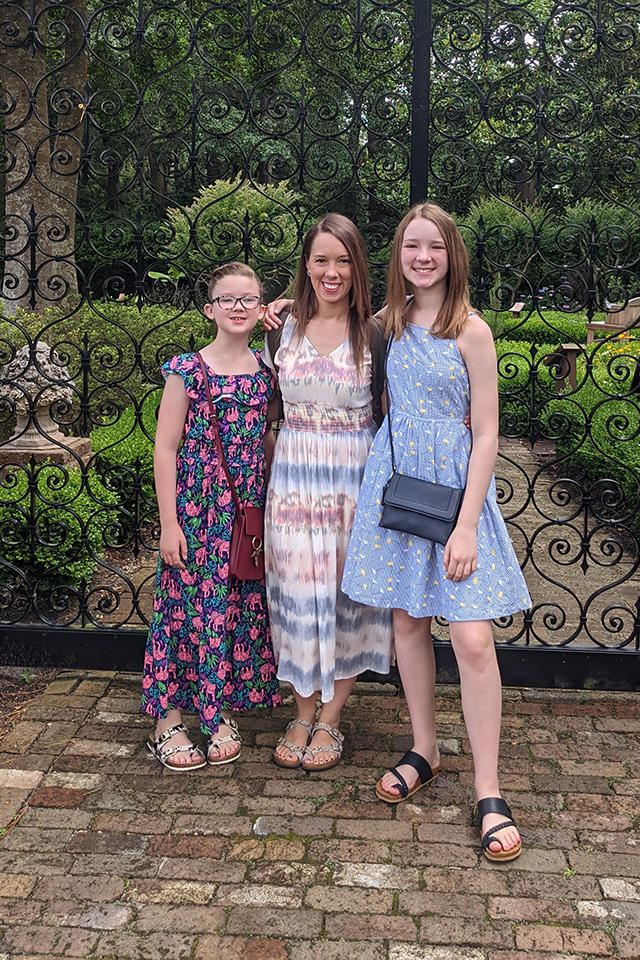
Molly Prendergast (right), now 13, and Ruby (left), 10, seen here with their mother, Kimberly, were 18 months and 6 months old, respectively, when they joined the hearing-loss study. “We were told when Molly was a baby that there wasn’t a lot of information about kids like her and more information was needed, so we were happy to help further the knowledge in the field,” Kimberly says. (Photo courtesy of the Prendergast family.)

